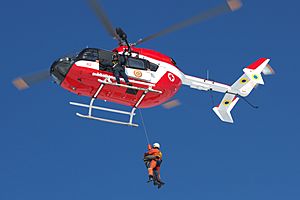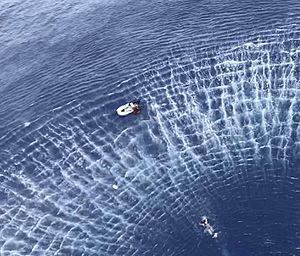Search and rescue facts for kids
Search and rescue (often called SAR) is when trained people look for someone who is lost or in danger. They help people who are hurt, stuck, or can't find their way back to safety. These missions often use special ships, helicopters, or land vehicles. Most search and rescue happens at sea or in the mountains. Civilian groups, the military, and firefighters all help with these important missions.
Sometimes, the military does a special type of search and rescue called combat search and rescue. This happens in war zones and is usually done by special forces.
Contents
Different Types of Search and Rescue
There are many different kinds of search and rescue operations. Each type needs special skills and equipment.
Ground Search and Rescue
Ground search and rescue looks for people who are lost or in trouble on land. This includes forests, deserts, and even near rivers or lakes. People might go missing for many reasons. They could get lost while hiking, have an accident, or need help because of a medical issue.
In most countries, the police are the main group that searches for missing people on land. Sometimes, volunteer search and rescue teams also help. These volunteers are highly trained and work closely with the police.
Mountain Rescue
Mountain rescue teams help people in tough, rocky, or snowy mountain areas. This can include climbers who are stuck or hikers who are lost or injured. Mountain rescuers are experts at climbing and using ropes. They know how to handle extreme weather and difficult terrain.
Cave Rescue
Cave rescue is a very specialized type of rescue. It focuses on finding and helping cave explorers who are hurt, trapped, or lost deep inside caves. Cave rescuers need special gear and training to work in dark, tight, and often wet spaces.
Urban Search and Rescue
Urban search and rescue (often called USAR) is about finding and saving people from collapsed buildings. This can happen after an earthquake, a terrorist attack, or extreme weather like tornadoes or hurricanes. USAR teams are made up of police, firefighters, and medical experts. They are trained to deal with dangerous situations like broken gas lines or live electrical wires.
Combat Search and Rescue
Combat search and rescue (CSAR) happens during wartime. These missions take place in or near battle zones. Their main goal is to rescue military personnel, like pilots whose planes have been shot down, from enemy territory.
Maritime Search and Rescue
Maritime search and rescue takes place at sea. These teams save sailors and passengers from ships in trouble. They also rescue people who survive plane crashes over water. Different groups handle maritime SAR, like the coast guard, the navy, or volunteer organizations.
When a boat or plane is in trouble, these groups send helicopters, rescue boats, or other special vessels. Sometimes, they do an air-sea rescue (ASR). This means they use both aircraft and surface ships together to complete the rescue.
Images for kids
-
A Canadian Forces AgustaWestland CH-149 Cormorant helicopter hoists a man from a Canadian Coast Guard cutter.
-
A SAR cruiser of the German Maritime Search and Rescue Service.
-
Canadian Forces CC-115 Buffalo fixed wing SAR aircraft from 442 Transport and Rescue Squadron.
-
A Cyprus Air Force AW139 SAR helicopter during a search and rescue demonstration.
-
Royal Danish Air Force S-61A with its rescue swimmer.
-
HK GFS EC155 helicopter.
-
Royal Hong Kong Auxiliary Air Force Aérospatiale SA 360 Dauphin SAR helicopter.
-
A search and rescue demonstration by an Irish Coast Guard Sikorsky S-61 helicopter and a RNLI lifeboat.
-
Italian AgustaWestland AW139 for sea rescue.
-
Sociedad de Salvamento y Seguridad Maritima AgustaWestland AW139 SAR helicopter.
-
Swedish rescue vessel Drottning Silvia (Queen Silvia) in front of the Royal Castle in Stockholm, Sweden.
-
REGA Agusta A109 K2.
-
HM Coastguard Sikorsky S-92 SAR helicopter.
-
US Coast Guard Eurocopter HH-65 Dolphin SAR helicopter.
-
Spanish Air Force Aérospatiale SA330J Puma of the 801 Squadron of the Air Force. Note the lettering reading "SAR".
See also
 In Spanish: Búsqueda y rescate para niños
In Spanish: Búsqueda y rescate para niños












































